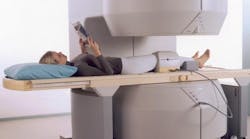Using an MRI (magnetic resonance imaging) machine in an operating room would be ideal for clinical monitoring of minimally invasive procedures (keyhole surgery), during tumor operations on the brain or liver, and procedures involving the heart. However, ferrous metal in traditional motors that drive the MRI’s rotating shield causes interference fields in the operating room. The patient, therefore, has to be moved to an adjacent room accompanied by an anesthetist in the middle of an operation to be examined using operative magnetic resonance imaging. Such brain tumor examination procedures have been successfully carried out at the Neuro-surgical University Clinic in Heidelberg, Germany, for 13 years.
In an effort to reduce the need to move patients, research has been conducted to provide an accompanying MRI exam inside operating rooms. Instead of the usual MRI tunnel system, new open MRI exam systems enable doctors to access the target area of the patient during image scanning. The need then, was to develop a rotating MRI-imaging shield driven by a completely metal free-system, including the motor.
Going metal-free
Because they must contain metals to generate magnetic fields to convert electrical power into mechanical rotational power, any electric motor was ruled out. Therefore, an air motor became the most likely solution. The challenge to develop a completely non-metal air vane motor was presented to the Development Department at Deprag Schulz GmbH & Co., Amberg, Germany. Gerd Zinn , the head of Serial Machine Development remembers: “This motor was needed for diagnostics in an MRI system where the use of metal would cause interference with the operating system. Therefore, it was not a suitable material for the application.”
Product Manager Dagmar Hierl added, “Our ferrite-free air motors were designed and developed especially for such an application. These Deprag air motors can play an important role in the development of medical equipment.” This motor is suitable for other applications where the use of metal is out of the question.
Modular designs make for easy customization
Deprag specializes in air motors. Hierl said that 85 % of all the company’s projects are special solutions. “We individually adapt the air motors from our catalog to fit our clients’ specific requests. We are able to develop cost-effective special motors because of our modular system,” Hierl said. “The spectrum ranges from single air motors to fully automatic production systems. Creativity and customer focus are therefore very important to us.”
The team set to work, drawing on their knowledge from decades of developmental projects involving air motors. The result: an air motor made of ceramic and synthetic materials that does not contain a single piece of metal.
| Circuits and systems made easy |
| Fluid Power Systems and Circuits, by Russell W. Henke, P.E., highlights circuit analysis and design flow for: constant and demand flow circuits, directional controls, pressure controls, and more. Complete with illustrations and easy-to-understand text, this book shows you how to analyze interactions of system components and how to pull an entire design together to meet anticipated loads and operating requirements. 400 pages, hard cover book, $80.00. Visit http://bit.ly/HPBooks to order. |
The prototype of the ceramic motor has a diameter of 40 mm and is only 78 mm long. Operating from compressed air at 2 bar, the motor transmits 150 W of power at a speed of 14,000 rpm. At its idle speed of 9000 rpm, it achieves 36 W power.
Because the entire motor system had to be metal-free, the pneumatic hose end fittings are also made of an engineered plastic. Three ports on the motor produce clockwise rotation, counter-clockwise rotation, and exhaust. In addition, valve circuitry is designed based on needs. For example, if one directional hookup is used (either CW or CCW only), a 2-position, 3-port valve is used. If bidirectional rotation is needed, a 3-position, 4-port valve will be used.
Zinn says the motor runs on oil-free compressed air. And although the research team did not require it, Deprag designers worked to reduce noise as well. To reduce noise from the motor assembly, a hose system was designed consisting of a combined inlet and exhaust hose.
For more details, contact Dagmar Hierl at [email protected] or Gerd Zinn at [email protected], call +49 09621 371-343, or visit www.deprag.com.
In the U.S., contact Lori Logan at Deprag Inc., at (972) 221- 8731, ext. 3806 or visit www.depragusa.com.



